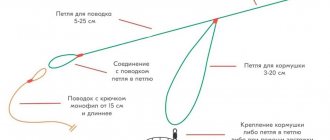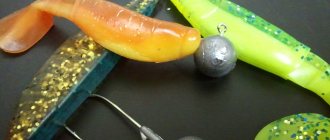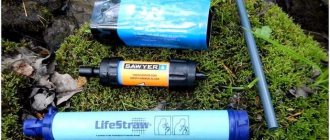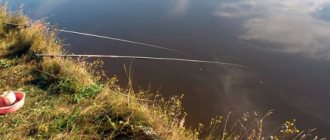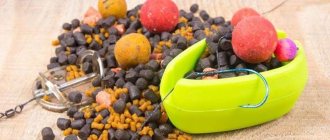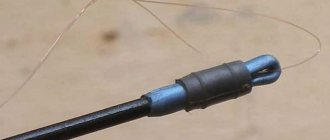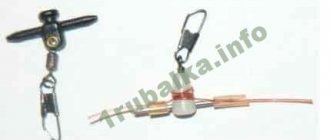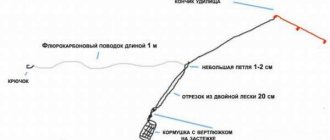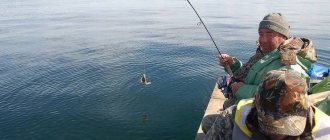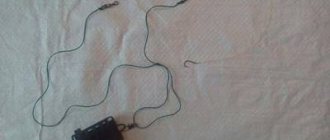Every little detail is important in carp fishing. Even choosing a sinker is an extremely responsible task, on which the effectiveness of the tackle directly depends. This is probably why sinkers of various shapes are used for carp fishing. Let's take a look and understand what characteristics this element of equipment should have.
When installing gear for carp fishing, it is important to pay attention to the choice of sinker
Why do you need a sinker on carp tackle?
Let's start with the basics and talk about why a sinker is used in the first place. In modern carp equipment it performs the following functions:
- Allows you to make fairly long and accurate casts.
- Fixes the bait rig at the fishing point, preventing the current from moving it.
- Presents the bait so that it is accessible to the fish.
- In most cases, it ensures self-hooking of the fish by the hook tip or promotes an effective bite.
As you can see, the sinker plays a fairly significant role. If you select it incorrectly for a specific tackle or certain fishing conditions, the number of bites decreases sharply. Moreover, the bite may stop altogether if this element of the equipment is chosen incorrectly. Therefore, you need to pay great attention to the choice of sinker. We'll talk about this further.
Thanks to the sinker you can make long casts
Long casting rod with sliding float
We begin the installation of a fishing rod for long-distance casting by installing the upper stopper strung on the main cord of the tackle. Having installed the stopper on the thread, a bushing carabiner is placed on the fishing line, to which the floats will be attached, and the device itself will facilitate the free movement of the alarm along the fishing line within the length limited by the stoppers. Having threaded the lower stopper, they begin to ship the alarm, mounting a garland of sinkers that stabilize the float on the water. The shipment ends at the fastener or loop formed at the end of the line. Depending on the fishing strategy, either a leash with a hook is attached to the loop, or a shock leader is installed between these elements. Having collected the elements together, they set the bait and begin fishing. In the process of assembling the tackle, I would like to pay special attention to such an operation as installing stoppers or tying specialized knots that help limit the stroke of the float, which we will talk about in the continuation of the article.
Stopper knots
A sliding float for long casting is designed not only to give the angler the opportunity to see bites, but also to deliver the bait to the desired water horizon. And as you know, sliding equipment allows you to fish regardless of the depth of the reservoir, but for this you need to competently be able to limit the distance the float moves along the fishing line. The fastest way for these purposes is to use rubber or silicone stoppers, mounting them on the fishing line at the points required by the fishing conditions. But experienced float anglers advise learning how to tie stopper knots yourself.
Important! Stopper knots made from fishing line are much smaller in size and softer than the factory rubber stopper, which gives advantages when casting, providing virtually no resistance when the line passes through the guide rings of the rod.
The easiest way to knit a locking knot is using the single locking knot technique or using the double locking knot technology known as kremkus.
Types of sinkers for carp fishing
Continuing to get acquainted with this important element of equipment, we will tell you about its most common options. Moreover, there are quite a lot of types of weights for carp. They all differ in:
- weight;
- size;
- form;
- fastening;
- material of manufacture;
- coating, etc.
That being said, one of the most important criteria listed above is weight and shape. They are mostly responsible for the casting range and the correct placement of equipment and bait in the water. So, we will pay special attention to them.
As for the weight of carp sinkers, it can vary from 1 to 300 g. Naturally, the lightest products are designed to equip a float fishing rod. For long-distance casting gear you will need a load weighing 20-30 g or more.
All weights vary in weight
Another important point is the shape of the sinker. If it is selected correctly, the effectiveness of the gear and the chances of catching carp will increase dramatically. Therefore, every carp angler should know which sinkers are most often used in equipment:
- Round. They have a banal ball shape. They “fly” quite well and provide minimal resistance when biting. True, they are not suitable for fishing on slopes, edges, etc., as well as in strong currents or wind.
- Pear-shaped. As a rule, they are distinguished by a flattened rather than rounded shape. Due to this, they lie stably on the bottom even in the presence of a current or various irregularities (slopes, edges, etc.). At the same time, they provide increased resistance when the fish bites, which can sometimes frighten it. They have excellent aerodynamic properties that increase casting distance.
- Elongated or elongated. In another way, they are also often called “bullets”, “sticks”, “torpedoes”, “horizons”, “long castes”, etc. They are most effective for long casts (from 100 m), because they have a streamlined shape.
Sinkers can have a variety of shapes - Cubic weights. Essentially, they have the same properties as round ones. They only allow you to fish without problems in water areas with uneven areas of the bottom.
- Frame. Made in the shape of a flat rectangular frame. They often also have spikes for better fixation at the bottom. Therefore, even with a small weight, such sinkers hold the equipment perfectly, despite the wind or current. Disadvantage: low flight performance when casting long distances.
- Arrow-shaped. Most suitable for fishing at medium distances, where there is no strong current. Due to its shape, which resembles the tip of an arrow, it allows you to quickly lift the equipment when fishing or recasting in order to overcome snags and overgrown areas.
Options for carp sinkers by type of fastening
As we found out, important characteristics for carp sinkers are shape and weight. However, it should be noted that they all differ in the type of fastening.
According to the type of fastening, sinkers can be through
The most common sinkers used in carp fishing are:
- With a through hole for fishing line. These are the so-called inline sinkers. Their popularity has only been growing recently. Largely due to both its effectiveness and safety. After all, if such gear breaks, the carp is easily freed from the load and equipment.
- Side or side-mounted weights. Naturally, they are not always mounted on the side. They received this name due to the fact that they are fixed on the equipment in a special way. That is, on the side of the main line.
Each of these options has its pros and cons. In short:
- "Inlines" are very easy to use and install. After all, no additional clips, cambrics, rubber bands, beads, etc. are required. Also, such sinkers perfectly detect even cautious fish and can be used in deep-sea areas. They also have “immunity” to overlap. Obvious “disadvantages” include the short casting range and the impossibility of fishing on a silted bottom.
There are also side-mounted weights - Side weights on the rig help make more accurate and longer casts. In addition, they sink less in silt (especially if equipped with a leg or swivel extension). Such a load also allows the fish to hook itself in most cases. The main disadvantage is the predisposition to twisting and tangling of the fishing line, as well as snags.
How to choose a hook for carp fishing?
So let's get started. The most important parameters of virtually any fishing hook (i.e., not just carp ones) are: sharpness (stings), shape of the structure, size, as well as the thickness of the wire from which it is (actually) made. Now let’s define the terms that are used to refer to the elements of the hook.
What are fishhooks made of?
From the image - diagram we see what the sting (point), fore-end (shank), ear (eye), beard (barb) and prying (bend) are. And we can figure it out further. To select the best characteristics for strictly defined methods of carp fishing, such parameters as “hook width” (gap), “total forearm length” and wire thickness are important. More in-depth/specific characteristics are “bite shape/height” and “front length” (where the sting is).
Depending on the shape (appearance), fishing (carp) hooks are divided into the following groups:
- with a shortened, “medium” or extended forearm;
- with straight or curved forearm;
- with a straight sting or “turned” towards the fore-end (slightly curved inward);
- with a sting in the same plane as the fore-end (classic version);
- with a tip bent to the side (“double-bent” curved in two planes at once / “single-bent” curved in only one plane) - see photo below;
- with a straight ear (the very first “simple” models);
- with a bent ear: either towards the sting, or away from the sting (i.e. outwards).
Fishing hooks: “single-bend” and “double-bend” It is definitely worth noting that these are only “conditionally” – the main types of hooks, since most modern manufacturers combine designs of individual hook elements. Thus, products are designed that are ideally suited to a wide variety of carp fishing methods. There are many variations!
However, despite the huge assortment, most carp anglers (over time) have established their favorite models (to which all world brands now adapt). A separate world is carp fishing, where “dangerous” (not (!) carp) hooks are prohibited, which contradict the principle: “if you catch a healthy fish, release the unharmed fish.”
What are sinkers made of for carp fishing?
Of course, most products are made from lead. In this case, the sinkers are covered with protective and masking material. Therefore, most models are olive, black, dark green or gray. This allows the load to blend into the bottom and be unnoticeable to the carp.
However, recently, sinkers made of stone can be increasingly found on sale. Unlike those made from lead, they are absolutely safe for the aquatic environment. In addition, stone sinkers have a better masking effect. Even the most attentive and timid carp is not afraid of a rig with such a load.
Usually the base for sinkers is lead
How to choose a sinker for carp tackle
When choosing a sinker for carp fishing, there are several things to consider. Which ones exactly? Let's list:
- Rod test. It is indicated on the form itself. May be in grams or ounces. Paying attention to the test, it is easy to understand which weight of the sinker will be optimal, and which, on the contrary, will load the carp form.
- Presence of current. If you are not fishing on a stagnant body of water, where there is a relatively strong current, then you will need a special type of sinker. These are flat models with spikes. Moreover, their weight can reach 250-280 g. If fishing takes place in still water, then you can use sinkers of absolutely any shape - ball, pear, cone, etc.
- Presence of bottom obstacles. In overgrown and snagged water areas, it is recommended to equip the rig with elongated sinkers, rather than teardrop-shaped or spherical. Since they are less susceptible to snags. In addition, experienced carp fishermen also use arrow-shaped sinkers. They are used to fish in areas where vegetation and snags are found near the shore. Such sinkers, when reeling in the fishing line, quickly raise the equipment above the bottom, protecting the tackle from snags and breaks.
When choosing sinkers, you should pay attention to the rod test - Bottom relief and its features. On a flat and hard bottom, you can use sinkers of any shape and weight. However, if the bottom is silted, then it is necessary to limit yourself to the lightest products. In addition, flat-shaped sinkers are preferable for fishing in areas with a large layer of silt. They do not allow the equipment and, most importantly, the leash with the hook and nozzle, to fall into the silt deposits. Also, sinkers with a side fastening for fishing line (rather than inline) are considered more suitable for catching carp on a “soft” bottom.
- Preferred casting distance. A promising fishing point may be located far from the shore. Then you need to use elongated sinkers weighing at least 80 grams. They allow you to cast as far as possible. If you need to cast the equipment literally 50-80 meters from the coastal zone, then a sinker of almost any shape will do. Its weight in this case is also unimportant.
- Weather. In particular, wind (sideways or headwind). If it is strong enough, then it is difficult to cast a tackle with a light sinker and hit the baited point. In this case, the optimal solution would be to increase the weight of the sinker.
When deciding which sinker to use, you need to take into account the bottom topography
If, when choosing a sinker for carp tackle, you take into account all the points listed above, you will be able to achieve a balanced tackle and correct presentation of the bait.
Carp montages
Among the rigs, the most promising and productive are bottom rigs for carp fishing. The compositions of such matings include not only sinkers, but also feeders, which differ from each other in shape, weight and size, as well as the principles of placing feed mixtures into the devices. Rigs are used in tandem with various types of fishing rods, as well as line gear. Variations in the fastening and connection of equipment components, the possibility of excluding or supplementing installations with various elements, allow you to create a wide range of ties that adapt the tackle to fishing conditions and fish behavior. We propose to consider the most common types of installations from more detailed angles, focusing on their features.
In line
Inline rigging is the easiest to form, has a logical assembly algorithm and does not require special tying skills, and also facilitates self-hooking of biting fish. A stopper is threaded onto the main line to limit the upper stroke of the feeder attached to the cord. Using the same technique, by means of a stopper, the lower limit of movement of the bait device is fixed. As a rule, the feeder has enough free movement on a piece of fishing line of 35–50 cm. After the lower stopper, a loop is knitted to which the leash of the required length will be attached.
Important! Instead of a feeder, it is allowed to include a sinker in the equipment.
Killer of crucian carp and crucian carp
How carp equipment is suitable for bottom fishing is the method of assembling the rig, according to the principle of the so-called crucian carp killer combination. The installation is not particularly sensitive, but with high fish activity it brings good results in terms of catches, without requiring special fishing skills from the angler, since the trophy is self-sealing on the hook.
The method is not considered sporting, but at the same time it is not poaching and is quite often used by carp hunting enthusiasts. Spring feeders are firmly installed on the main cord, sequentially, 5–10 cm apart from each other. A swivel is placed at the end of the fishing line, to which a weight is attached. The feeders are equipped with short leashes with hooks, which are inserted into the feed mixture, tightly packed into the spring, and are sucked in by the carp as they eat the food.
Blind equipment
It is enough to simply tie a carp rig using the blind method. For these purposes, a triple swivel is mounted at the end of the main cord. A weight is placed on the side ring of the swivel using a quick-release carbine, and a short leash with bait is attached to the remaining eye. The equipment guarantees long-range installation and quick hooking of fish, but is not considered delicate. In addition, it demonstrates the best fishing results in shallow waters on clean bottoms with a firm structure.
Equipment with anti-twist
This kind of installation for a feeder is perfect for fishing in strong currents, as the bite is transmitted well and the reel holds well. The main argument of opponents of equipment with an anti-twist is the presence of a foreign object that can scare the fish.
The assembly proceeds as follows:
- The monofilament thread is inserted into an anti-twist machine equipped with stoppers at the ends.
- The lower swivel is fixed, after which there is a leash with a hook.
- Mounting the feeder on a carbine.
- As a result, the long end should be in the direction of the leash.
Equipment with anti-twist
Helicopter
A feeder installation of this type will be optimal for fishing from long distances and in the current. Even in cases where a lot of effort and a lot of patience are spent during creation, the helicopter will pay off.
To create a montage, prepare:
- leadcore with a clutch and an igloo for it;
- two rubber beads;
- cargo;
- swivels;
- thermal shrink tube (length - from 40 to 60 millimeters);
- PVA bag.
Installation process:
- The sinker is installed on the shock leader.
- A coupling is put on the swivel and leader using a needle.
- The weight is attached to the thermal tube.
- The leash is attached to the swivel ring, the shock leader is attached to the monofilament.
- We must not forget about ensuring the free movement of the beads along the thread to the knot.
- The sinker and bait are poured into a PVA bag.
Equipment “Helicopter”
Safety clip
This installation technique is particularly popular. If it catches tightly, the weight will move away. To create a secure clip, you need a clip, a weight, a cone-like coupling, a swivel and a rigging house.
Assembly instructions:
- A monofilament thread is inserted into a 300 mm tube.
- Its end is threaded through the coupling and compressed into a tube.
- The swivel and coupling are mounted on a clip.
- The swivel is attached to the other end of the monofilament.
- Then it is threaded through the clip and attached to the leash.
“Safety clip” accessory
Harvester
There are almost no differences between this equipment option and a standard carp spring, but there are additional advantages:
- Firstly, the combine is easy to make.
- Secondly, casting can be carried out over long distances.
- Thirdly, the system is simply convenient.
Creation instructions:
- The springs are made cone-shaped. At the narrowest point their size should be no more than 2 mm, and at the widest point - 4 mm.
- The total length of the feeder is up to five centimeters.
- The eyelet is made on its upper part, the swivel is attached to it.
- The main line is tied to the swivel.
- 3-5 leashes, up to 8 centimeters long, are attached to the carbine.
- It then fits onto the swivel at the top.
- One of the leads is pulled out through the spring.
Harvester equipment
Flat method
A very famous installation option. The appearance of the feeder resembles a balalaika, one part of which is flat. The equipment is perfect for fishing in those reservoirs where the bottom is covered with marshy silt or deep algae, because it will not fall into them.
Flat feeders provide good casting accuracy and range. You can also make them yourself.
For this you will need:
- stainless steel wire;
- metal pin;
- plastic tube;
- the mold in which the lead base will be cast.
How to assemble:
- A bent wire with a pin is placed in a mold into which molten lead is poured.
- After cooling, the product is pulled out, the pin is removed, and a plastic tube is glued in its place.
Carp rig “Flat method”
Other types of sinkers
You can’t do carp fishing without marker weights. They are not installed on fishing equipment. Their purpose is to check the bottom topography and identify its features. Therefore, marker sinkers are made of an unusual shape (somewhat reminiscent of a mace). They also have many protrusions, bumps and bulges, which help to “listen” to the bottom in the fishing area, identify silted areas, holes, shell rock, snags, edges, etc.
In addition to marker sinkers, carp anglers actively use feeder sinkers. Especially when carp are caught in early spring. After all, at this time there is no need for heavy feeding. Just a little bait is enough to attract fish. Feeder sinkers are used precisely for these purposes.
Using marker sinkers, you can learn about the features of the bottom of a reservoir
You can bake carp by stuffing it with rice. In addition, among fishing products you can also find sinkers that have a special capsule with flavoring. Once in the water, it gradually dissolves, attracting carp with its rich smell. There are also sinkers that have a unique porous surface. A liquid attractant is already applied to it to lure carp.

